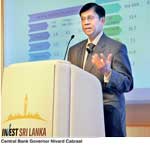
Friday, 06th June 2014
Central Bank Governor Nivard Cabraal last week told the Investor Forum in London that the high economic growth momentum achieved following the end of the conflict was continuing, with capacity for new investments being progressively expanded.
Delivering the keynote as the Chief Guest, Cabraal briefly highlighted Sri Lanka’s recent macro economic achievements and also gave an indication of the future outlook.
Following are excerpts from Cabraal’s presentation:
 Let me give you an overview of what we are going to do and why we think that what we are going to do will work for the future of Sri Lanka.
Let me give you an overview of what we are going to do and why we think that what we are going to do will work for the future of Sri Lanka.
There are two core areas that the Central Bank is responsible for; inflation and price stability and financial system stability. Therefore, let me speak a little on inflation.
In the case of price stability, Sri Lanka has not done very well in the past. Historically we have been a high inflation country with inflation at around 12%, for 30 years. That is not a very good position to be in, but that has changed and now for the last 63 months we have been able to have inflation at around the 6% mark and coming down.
However, this has not happened by accident, there have been favourable supply-side changes that have been and there is also the demand that has been contained. There is a clear path that we have chartered for the economy and we can say that in the foreseeable future Sri Lanka would enjoy mid-single digits, sometimes even lower than that. That has also anchored the inflation expectation which is a vital part of inflation management.
Sri Lanka has got the balance right
Many countries have the challenge of ensuring that there is growth while containing inflation; Sri Lanka has been able to get that balance right. In the past four years we have had growth of about 7.5%.
In the growth model that we have envisaged for the country, the industry sector has been increasing and the service sector has also been improving. So from a $ 24 billion economy in 2005, it has now increased to $ 67 billion and in the next three years we expect the economy to reach the $ 100 billion mark. Per-capita incomes have also risen quite significantly, in the last few years we have grown rapidly to the $ 3280 mark and we would move to the $ 4,000 per-capita mark by 2015.
Unemployment has come down to 4.4%, and we are keeping a very close tab on it. Merchandise exports and imports have also been strong, particularly this year (2014), every single month has seen more than a billion dollars of exports. Worker remittances and services exports have also been rising quite rapidly; we are happy to see the $ 1,550 million in 2005 rise to $ 4,500 million in 2013. Additionally our external current account deficit is also shrinking and now it has shrunk to 3.9% of GDP and it is expected to shrink further in the coming years.
FDIs have shown a rapid improvement; the average in the last few years has been about $ 1 billion and now we are moving towards about $ 1.5 billion. The BOP surplus is now becoming quite clear and in the next few years Sri Lanka would see constant BOP surplus. Depreciation of the currency has been very low in the last few years and we have been able to manage it at around 3% in the past eight years, but going forward we see that being managed at a much more stable rate.
Financial sector developments
The financial sector, I won’t go into details, however the assets in sector have been growing quite rapidly from Rs. 3.1 trillion to about Rs. 10 trillion now, and is expected to rise much further in the next few years. While that has that been done, the banking sector has seen major strides.
Sri Lanka’s debt levels have also been managed very prudently and from a very high level, but today it has been brought down very gradually. Again, significantly our average time of maturity to our debt portfolio has also doubled in the last few years and we now see an overall yield curve which goes up to 30 years. All these developments and trends have given rise to a new paradigm for Sri Lanka.
That vision for the Sri Lankan economy envisages a growth of about 8% per annum on a sustainable basis; for that to happen, an investment level of about 33% of GDP is targeted. However, there is a balancing act where we need to decide how much of the necessary investment should come from outside and how much of it must be local and how we manage that process.
Multiple avenues for investments
We have created multiple avenues for investments to come in, but at the same time there must be takers within the economy, so that those investments can be absorbed within the economy. Investments cannot work in a vacuum; there is a vital framework that needs to be put in place. Firstly we needed to bring peace into the country and that took an enormous amount of effort. Thereafter we restructured the economy and we have worked on ensuring that the country’s entire infrastructure was developed to a much higher level than what it was.
That economic momentum has continued and a high growth path has been achieved. We are far ahead of our peers and regional countries in terms of Global Prosperity Index, as well as the Human Development Index.
Sri Lanka was ranked best in South Asia in the Doing Business Index (DBI) 2014, but we are not satisfied; we want to come into the top 30 by 2016. At the same time our concentration on infrastructure has also been extremely important, to ensure that people who come in to do business can do business without any trouble at all. This is set out in the ‘Mahinda Chinthana’ concept of the five hubs for Sri Lanka. As I said earlier, in order for investments to come in there has to be capacity built in the economy. In order to channel these investments we identified five areas: commercial, aviation, maritime, energy and also knowledge hub.
The external financing gap will now be able to bridge the savings gap; as time goes on the amount that we have to rely on from outside will definitely be less, because we will have to rely on less from outside the country. A BOP surplus of around $ 3 billion is expected by 2016, as a result of all these new developments. We are also aiming at ensuring that Sri Lanka going forward has high growth but low inflation.
A new virtuous cycle
We have created a new virtuous cycle from what we had in the past, where we had a vicious cycle, where we had high inflation resulting in high interest rates, low investor confidence and sluggish investments to low growth, high debt levels and high fiscal deficits, which has been shifted. In our new virtuous cycle we have low inflation, higher growth and lower debt levels. All this will help us to move into a new phase of our country, where Sri Lanka becomes a truly middle income country.
We are working on taking this momentum into creating better investor confidence in the country and the SEC and CSE have been working on this, to ensure that there is a level playing field and there are good norms and good regulatory action taken to ensure that all of you are protected when you come into the country and invest.
From : http://www.ft.lk/2014/06/06/high-economic-growth-momentum-is-continuing-nivard-tells-london-forum/




